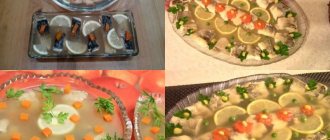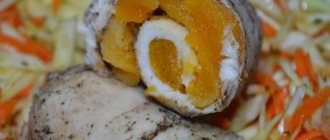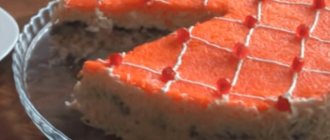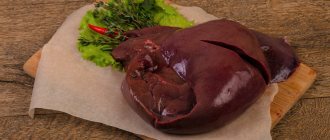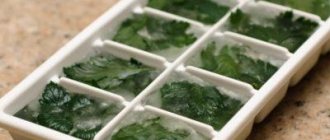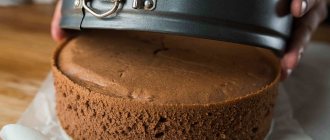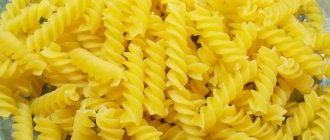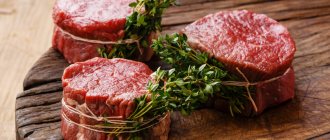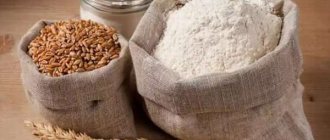Fish aspic is an excellent appetizer for any holiday table. There are many options for preparing this dish. The aspic can be prepared with or without gelatin. But the highlight itself lies in the design of the aspic. A beautifully decorated fish dish will perfectly complement the festive table.
I would like to suggest you prepare fish aspic with gelatin. For the dish we will take pike perch. And we will need these ingredients: 0.6 kg of pike perch, tails and heads of any fish about one kilogram, one medium onion, one medium-sized carrot, five to seven peas of allspice, five bay leaves, one glass of dry white wine, salt to taste, one pack of gelatin.
to decorate the aspic: fresh dill or parsley, two eggs, one medium lemon, several fresh cranberries.
1. Clean fresh fish. Remove the entrails and gills. We cut off the fins. Cut off the head and tail. We wash and dry the fish. Along the ridge we cut the pike perch into two parts, cutting off the ribs at the place where they are attached to the ridge. You will get two fish fillets. Carefully remove the remaining bones and ribs from the fillet.
Lubricate the food foil well with vegetable oil. Take the fish fillet and place it skin side down on the foil. Add pepper and salt and then wrap tightly in foil. Preheat the oven to one hundred degrees. Bake the pike perch in the oven for one hour. The finished pike perch will be tender and very tasty. In addition, it will not lose its shape. Cool the fish and put it in the refrigerator for five hours directly in foil. The fillet will become dense and easy to cut.
2. Now we begin to prepare the fish broth. Place the bones, fins, tail and head from the pike perch in a pan along with other fish tails and heads. Rinse thoroughly. Fill with water, add allspice, bay leaf, carrots, and whole onion. Set to cook over medium heat. After boiling, cook the broth for twenty minutes. Then add one glass of dry white wine.
Remove carrots and onions from the broth. Cook for another fifteen minutes over low heat. We will need carrots for decoration. Add salt to taste. Remove heads, bones, tails and fins from the broth. Strain the broth itself through cheesecloth folded in three layers or a very fine sieve. To prepare jellied fish we need one liter of broth. Cool the broth and place it in the refrigerator for three hours. During this time, all suspensions will settle to the bottom.
3. Drain the cooled broth, leaving sediment at the bottom. Pour gelatin into the broth as indicated in the instructions. When it swells, heat it, but do not bring it to a boil. Stir until the gelatin is completely dissolved. Now add the remaining broth to it and mix. Pour some broth with gelatin into a wide, deep dish and put it in the refrigerator for two hours. Cut the pike perch fillet into slices and place it on the frozen broth, skin side up.
4. Boil hard-boiled eggs for ten minutes. Cool, peel and cut into slices. Place in the middle on the fish fillet.
5. Wash the parsley, dry it and tear off the leaves. Place a leaf on each fish fillet. We cut the carrots into half circles and also place them on the fillet along with cranberries and thin lemon half rings. Pour in the rest of the fish broth. Place in the refrigerator to allow the fish dish to completely harden.
6. Take the fish aspic, the recipe for which I offered you, from the refrigerator and serve. I wish everyone a bon appetit!
Decoration products
Decorating aspic dishes is an incredibly exciting activity, despite the fact that all this cooking takes quite a lot of time. But how nice it is to receive compliments from guests for your efforts in the kitchen. Therefore, we arm ourselves with ideas, and, most importantly, the necessary products, and begin to sculpt beauty.
For fish aspic, beautifully decorated slices of lemon and lime would be an excellent option for garnishing. The contrast of yellow and green always looks impressive, and in the company of gifts from the seas and oceans, this citrus tandem will become irresistible.
Seafood looks very beautiful in fish jellied fish: baby octopuses, shrimp, shining eggs. But diluting the marine fauna with terrestrial flora is also not prohibited, but on the contrary, it is encouraged.
You can safely add capers and gherkins to the aspic; the overall appearance of the dish will only benefit from this.
A riot of colors and brightness of color will bring colorful vegetables to a gelatinous appetizer, either fish or meat. Boiled carrots, for example, are the most favorite decorative material for all housewives.
However, from onions and green onions, colored bell peppers, yellow, black and red tomatoes, cucumbers and various greens, you can create truly incredible pictures from ordinary patterns and colors to complex landscape compositions.
Green peas with sunny corn, variegated beans, olives, pomegranate seeds and cranberries, which also play an important aesthetic role in all this splendor, will immediately come to the rescue.
Natural motifs under a layer of transparent meat or fish jelly also delight the eyes of eaters. Mushrooms and basil leaves can create a real autumn painting on the table.
Well, how can we do without boiled eggs, this product can easily be considered the main artistic element. Making lilies, chrysanthemums and daisies, swans and other beautiful figures from pliable protein is as easy as shelling pears, but this design of the signature New Year's snack dish will look simply stunning on the table.
Technology for decorating jellied dishes
Well, if we have figured out the selection of products for decoration, now it’s time to discuss all the subtleties and secrets of beautiful presentation of jelly.
Transparency
Firstly, the main advantage of a beautiful aspic lies in the transparency of the broth. If the broth is crystal clear, then any, even the simplest decoration of the dish will look amazing.
Cloudy jelly, on the contrary, threatens to spoil even the most meticulously and artistically ideally compiled “herbarium”.
Dishes for aspic
Secondly, you should decide in advance which type of serving of the gelatinous snack is preferable for you. For example, at an official reception, portioned aspics served in separate glasses or bowls are very effective.
With your family or close circle, you can limit yourself to a shared dish. This is what determines what design you should choose for the appetizer.
The history of jellied meat
Favorite dish: jellied meat
An analogue of jellied meat was a strong meat broth. It was made back in ancient times. In the cold it turned into a viscous mass, and this was inconvenient, because the broth had to be heated all the time.
However, the northern peoples began to prepare this dish in cold form. It was specially taken out into the cold. In particular, the Slavs called this delicacy jelly.
In Russia, jellied meat was initially prepared from various leftovers after a feast, so this dish could not be called a delicacy. In France, this dish was improved by clarifying the broth and adding aromatic herbs. This is how Russian aspic or Russian jelly turned out, which later, after going through some changes, became Russian jellied meat.
Here the rich history of jellied meat is described quite briefly; in fact, there are many more interesting points.
One large aspic
Making one large jellied meat does not imply its subsequent removal from the mold and is served, as a rule, in a large container. There are incredibly many decoration options for this type of aspic.
You can simply place the meat on the bottom of the plate, pour a small amount of broth over it and leave to cool in the cold. After that, on top of the frozen jelly, we steal any combination of vegetables, eggs or herbs you like, and then carefully pour in the rest of the broth.
These options can be considered classic. But how can you decorate the aspic in a more original way?
Cooking time
Since jellied meat can only be made transparent by prolonged cooking over low heat, you need to be patient. The languishing takes place for at least four hours. You can make sure that it is time to complete the cooking process as follows.
Carefully remove the leg and try to separate the meat. The seeds should separate easily and dry quickly, becoming matte. If so, remove the pans from the heat and let the contents cool until lukewarm.
Design of jellied tongue “swans in a pond”
In this case, we will decorate the jellied meat after it has hardened. Therefore, having laid out carefully cut slices of boiled tongue at the bottom of the container, fill everything with broth with gelatin and set it to harden. Well, after 4 hours you can begin to directly decorate the dish.
Ingredients
- Boiled eggs - 4 pcs.;
- Onion head - 1 small piece;
- Boiled carrots - 1 pc.;
- Black peppercorns - 4 pcs.;
- Dill and parsley - 1 bunch;
- Basil - 4 leaves;
- Garlic arrows or wild garlic – 10 pcs.
- Dough – 50-100 g;
- Ground coffee – 2-3 tsp;
Reeds
We make reeds. We stick pieces of dough onto the ends of 6 garlic arrows, no more than 10 cm long, and then roll them in coffee until the dough turns brown and looks like reeds.
Lilies
Now let's make lilies. Cut the onion head in half crosswise and cut out corners from each half, making a flower.
After this, we rotate the onion layers around an axis, giving the product the shape of a lily. And in the center of this beauty we place thin and short carrot sticks - the stamens of the lily.
Swans
Well, the next stage we will have swans. Cut off the white of 2 boiled eggs a little on one side for stability. We cut out the tail from the cut, and cut off the barrels of the other two eggs - these will be the wings of the swans.
Next, insert the resulting parts into the cuts on the side of the wide part of the egg (tail) and on the sides (wings). We also cut out the neck and head for each bird.
After this, we attach the part to the “body” with toothpicks. We make paws and beak from boiled carrots, and eyes from black peppercorns.
Assembling the composition
Now you can assemble a landscape composition. On one side of the dish with jellied tongue, place chopped dill and parsley as herbs.
We stick the reeds and the remaining garlic arrows there. We place swans nearby, and onion lilies with basil leaves a little further away.
And here is the result.
Grapes in pink champagne
Ingredients for 3 servings:
- grapes - 3 bunches;
- pink champagne - 300 ml;
- sheet gelatin - 5 pcs.
Soak leaf gelatin for 10 minutes in cold water. Pour 100 ml of pink champagne into a bowl and heat for 30 seconds. into the microwave oven (at full power).
Place soaked gelatin (squeezed out of water) into a bowl of hot champagne and stir until it is completely dissolved, and cool at the same time. If foam has formed on top, remove it with a spoon. Now mix the gelatin mixture with the rest of the champagne (200 ml), and if foam forms again, remove it with a spoon.
Place bunches of grapes in molds (tea glasses, cups) and fill with jelly champagne. Place the molds in the refrigerator for at least 4 hours.
Before serving, dip the molds for 2 seconds. into hot water and, gently pulling the tail of the grape, easily remove the jelly. Serve jelly grapes with any soft cheeses, poultry pate tartlets and champagne.
"Peacock" decoration
There is another equally effective, but easier to implement option, how to make a jellied tongue using “egg birds”. In this case, the painting from aspic can be called “Peacocks”. For decoration you only need a couple of eggs, a few pitted olives and green onions.
- It is necessary to arrange slices of boiled tongue at the bottom of the dish in the shape of a peacock's tail, after which we place circles of chopped olives on top of each of them.
- Next, beautifully arrange the green onions between the meat pieces. The greens should be positioned so that the sharp tips point upward.
- Well, at the base of the entire structure we lay out three bird figures cut from egg white sides. We form the nose from boiled carrots, the eyes from pieces of olive.
- We decorate the bottom of the dish with curly parsley and then very carefully pour the broth mixed with gelatin over everything. After hardening, this treat will become the main decoration of the table.
The best recipe
Before you decorate the jellied meat, you need to cook it. Each chef has his own ideas about what should be included in the base. However, most of them agree that the most delicious jellied meat comes from a broth made from several types of meat. For it, take veal legs, chicken giblets or wings and a piece of lean pork. If you are using this recipe for the first time, add the ingredients in equal parts. Later you can change the ratio in favor of one of the components.
Preparation of jellied meat begins with boiling beef; it takes longer to cook than other types of meat. Pour cold water over the legs and bring to a boil over low heat. After about forty minutes, pork is added to the pan, and after another half an hour, chicken. Additional ingredients used when preparing jellied meat are whole onions and carrots, bay leaves and allspice. A sign that the base for jellied meat is ready is the ideal softness of the meat.
Fish aspic
Recently, to make beautiful jellied meat, smart housewives have adapted silicone molds for cupcakes and jelly for this task. And it is worth noting that a dish prepared using such forms looks simply incomparable.
However, special containers made of silicone or ceramics are now produced for jellied meat. Decorating fish aspic today is not a difficult task if you have such a special form in the house. But how can you add a special charm to a dish?
For example, you can cook colored jelly fish with plenty of vegetables and a lemon scallop.
- To do this, place thin slices of lemon and green olives on the bottom of the mold.
- After this, we separately grind the fish fillet, red, yellow and green bell peppers, a little tomato and pickled cucumber, and then mix it all with gelatinous fish broth and pour it into the mold.
After hardening, we will have a magical and tasty jellied fish.
If there is no form
However, if you don’t have such a lifesaver at home as an original mold, then you can simply place neatly chopped fish slices on the bottom of a transparent container and pour a small layer of broth over them.
After hardening, we lay out greens, pepper circles or peeled and boiled shrimp, octopuses along the walls of the container, in general, we create beauty at our own request, and then fill everything with the rest of the broth.
Fish aspic looks very beautiful in portioned containers, such as glasses, ice cream makers, wine glasses, glasses. And most importantly, it’s practical, because guests won’t have to feel the awkwardness of reaching across the entire table in the hope of getting their share of the goodies.
Other materials
Home charging in isolation
Most people need to self-isolate at home, but how can you stay fit in these conditions? Morning exercise is the easiest way to get a boost of energy for the whole day.
Marinade for chicken kebab
With the onset of warm days, most of us begin to dream of real kebab, cooked with our own hands. You can make shish kebab from almost any meat, poultry or fish. But everyone especially loved the chicken kebab. In addition to the obvious availability, chicken meat is soft, juicy and tender. The chicken marinates quickly and cooks even faster. Also, chicken kebab can be considered the most dietary, especially if fillet was used as the base.
Pig from a bottle
In addition to silicone and ceramic fish, you can often see quite funny and cute piglets on sale. In such molds, the decoration of jellied meat will become truly masterpiece.
But even in the absence of a formal kitchen assistant, a pig can be made from such handy tools as an ordinary plastic bottle.
For example, if you pour gelatin broth with chopped meat and pre-designed vegetable decorations into a bottle, and after the jellied meat has hardened, carefully cut the plastic and take the snack out into the light, then using simple manipulations you can make a cute little pig.
All we have to do is decorate the meat aspic by cutting out ears and a snout from boiled carrots, making eyes from olives or peas, and a tail-hook from sausage. Original, beautiful and simple.
A little creativity
Another recommendation: to harden the jellied meat, do not take plates or molds with a smooth bottom, but transparent plastic cake lids. And when you transfer the frozen dish to the dish in which you will place it on the table, be sure to place the jellied meat upside down. The relief design of the lid will be imprinted on the jelly surface of the jelly. Here's how to decorate and serve food that has long been known, familiar and beloved to everyone in an original way!
Jellied on the festive table "Faberge"
Despite the fact that the Easter holidays have already passed, this design of chicken aspic never loses its originality. How could it be otherwise, because it’s not often that you come across such beauty and deliciousness on the table.
To bring this wonderful snack to life, we will need several eggshells with a hole on the side of the wide base. The inside of the container should be thoroughly rinsed and the white film removed.
After this, in order to decorate our masterpiece and give it freshness, we fill the shells with finely chopped vegetables (tomatoes, peppers, carrots, corn, herbs) and 2/3 chicken meat. And then pour chicken broth with gelatin diluted in it.
After hardening in the refrigerator, all we have to do is peel off the shells from the jellied “eggs” and place them on a dish.
Preparing jellied meat is undoubtedly not an easy task. However, even at the finish line of this entire kitchen, an equally important stage awaits us - decoration. Many housewives do not know how to decorate aspic in an original way, but we hope that our tips will help solve this problem.
- Author: Maria Sukhorukikh
Rate this article:
- 5
- 4
- 3
- 2
- 1
(0 votes, average: 0 out of 5)
Share with your friends!
Chicken feet - benefits and harm for joints
Every person remembers the great taste of homemade jellied meat with spices, but rarely thinks about its possible effect on the health of the musculoskeletal system. Chicken feet are used to prepare jelly - the benefits and harm to joints from eating this part of the bird have been discussed for many years. The use of paws is common in Asian countries. In Russia and surrounding regions, such food is often considered second-class and is used to feed animals. Interest in the product is explained by its nutritional value - the content of certain types of collagen, as an indispensable participant in the full functioning of joints.
Why eat chicken feet?
Jellied meat is prepared from different types of meat with bone cuttings. During long-term heat treatment, they release microelements into the broth. It is very useful to take chicken feet as the basis for a “jelly” recipe for people with problems with osteochondral tissue, the benefits of which will depend on the frequency of use and the individual characteristics of the body.
Patients suffering from arthrosis or arthritis need an increased intake of collagen - a specific substance with a protein structure that is responsible for the strong connection between body cells, ligaments, and tendons. Its presence in the broth boiled on the paws allows the jellied meat to take on a jelly state when cooled, and at high temperatures its consistency resembles glue. It is enough to use this product several times a week to:
- relieve swelling and stop inflammatory processes;
- annihilate the development and worsening of the degree of cartilage damage;
- activate blood circulation in areas of joint pain;
- cause remission of the pathology;
- eliminate excess body fat, since collagen is involved in fat metabolism.
Systematic intake of chicken collagen leads to a reduction in the symptoms of non-chronic arthrosis by 45% over 3 months without obvious or hidden (long-term) side effects.
The joint consists of 20% undenatured type 2 collagen, 5% hyaluronic acid and chondroitin sulfate. These substances are present in aspic from chicken feet in sufficient quantities along with protein, calcium and other minerals (zinc, magnesium, copper, phosphorus). They promote the regeneration of nerve endings and muscles, the restoration of cartilage tissue, being a “building” material without resistance from the immune system.
As a result, the patient feels relief, the mobility of all joint parts increases, the composition and viscosity of the synovial fluid improves, and vital activity increases.
Natural product or medical preparations?
The disadvantages of this method of treatment are limited to:
- Possible allergic reactions (1 case in 1000).
- A decrease in blood pressure after 5-7 hours (hypertensive patients have nothing to fear).
- The product has a high calorie content - about 200 kcal per 100g, which should be taken into account by people on a strict diet.
This “harm” can be prevented by reducing the dosage and frequency of use or completely abandoning collagen therapy. You can purchase similar pharmaceutical nutritional supplements made from biomaterials from large livestock or marine fish, but they are expensive. Many people have appreciated chicken feet for joints, which allow them to save money on branded collagen capsules without compromising the quality of treatment, because the concentration of nutrients in the feet is not inferior to the composition of expensive drugs.
Elderly people will especially benefit from chicken foot soup; with its constant consumption, they will significantly reduce the risk of bone fragility. This method of strengthening ligaments is often used by athletes and patients when recovering from various injuries, including spinal cord injury.
Table of the effectiveness of medications as an alternative treatment method in comparison with food products based on chicken feet.
| Remedy | Pathology | Proven therapeutic effectiveness (course duration – 3 months), % improvement from indicators at the beginning of the test |
| Undenatured collagen type 2 Cll | Rheumatism, osteoarthritis of the knee joint | 40 |
| Chondroxide tablets + chondroprotector ointment Horsepower “Horse Force” | Shoulder osteoarthritis, arthropathy | 33 |
| Osteal with systematic joint injections with Alflutop | Osteochondrosis of the thoracic (with partial damage to the cervical) spine | 37 |
| Jellied meat based on chicken feet (12 pieces per 1 liter of distilled water) | Coxarthrosis of the hip joint | 42 |
Experts have come to a logical conclusion: it is advisable and preferable to first give the body the nutrients it needs to heal itself, and then begin alternative therapy. This will eliminate possible side effects in the form of intestinal blockage or destabilization of the activity of internal organs. Since food products based on chicken feet are completely natural and harmless to health, the only exceptions are cases with the need for 100% surgical intervention, which require complex and increased attention from doctors.
Conclusion
Chicken feet are a product that many people pay attention to when planning to prepare jellied meat. This part of the bird is unattractive, but at the same time it serves as a source of useful substances for cartilage tissue. Chicken feet can be eaten if you are predisposed to arthritis and arthrosis. The beneficial components of this part of the bird are microelements, macroelements and vitamins, which are able to retain their beneficial properties even after cooking. The result of use is increased elasticity of cartilage tissue, improved joint mobility.
Share link:
- Add to favorites
